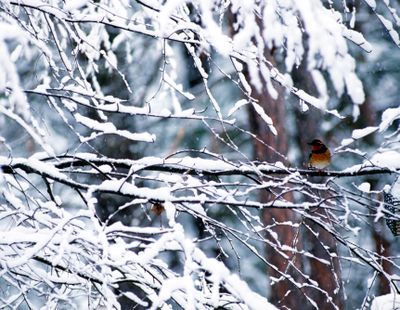Annual Christmas Bird Count isn’t ready to be replaced by technological advances

Inland Northwest birders are among the thousands in roughly 2,000 localities across North America and beyond that will be flocking together in the next few weeks for the 111th annual Audubon Christmas Bird Count.
New birders are invited to join avid birdwatchers on more than a dozen counts that are being organized within 100 miles of Spokane.
Each volunteer group will count for one day between Dec. 14 and Jan. 5 in a designated circle 15 miles in diameter.
Area Audubon groups offer 10 counts on four different days during that period. Some birders join in more than one.
The count began on Christmas 1900 in 25 eastern localities where groups publicized the pleasure of identifying, counting and recording all the birds they saw.
Apart from its main attraction as a social and competitive event, the databases generated by online reporting have boosted the Christmas count’s value in generating a “snapshot” and monitoring the long-term status of resident and migratory birds across the Western Hemisphere, National Audubon officers said. The data reported by volunteers are combined with more scientific survey methods to help ornithologists study myriad issues, such as the magnitude of West Nile virus and climate change.
However, some area birders wonder if the trend toward regular Internet filing of birding observations might make the big fling of the Christmas Bird Count obsolete.
“Now we have eBird, which compiles what a lot of people are seeing every day of the year, said Terry Gray, an ardent Moscow birder who canceled the 2010 CBC outing he’d organized in Lewiston for lack of interest.
The eBird website, sponsored by the Cornell Lab of Ornithology and the National Audubon Society, has revolutionized the way birdwatchers report and accesses information about birds with a real-time, online checklist.
Launched in 2002, eBird electronically compiles data sources for basic information on bird abundance and distribution at a variety of spatial and temporal scales.
The work is done by a vast network of volunteers. In January, participants reported more than 1.5 million bird observations across North America.
“There’s probably some value to a big blitz on one day, but it seems that a lot of the data and trends in bird populations are being handled now by eBird,” he said, noting that birders a century ago never thought this would be possible.
But Kim Thorburn of the Spokane Audubon Society said there’s great value in the Christmas Bird Count even in the digital age.
“First, the Christmas Bird Count is a different methodology,” she said, noting that she’s familiar with monitoring population dynamics as the former top public health official in Spokane County.
“Second, it has a 110-year history for comparisons. It provides us with trends that I think will not be available by other means for a long time. I don’t think we’d want to stop something just because we suddenly have a new digital form.”
A record 2,160 groups counted birds the old-fashioned way last season using binoculars and their ears to tally almost 60 million birds.
Idahoans have been participating since 1914, when the state’s first Christmas Bird Count was organized in Moscow, said Shirley Sturts of Audubon’s Coeur d’Alene chapter.
New birders are always welcome to join the counts, said Alan McCoy, the local chapter coordinator of groups that will be heading out on Jan. 2 for the Spokane count.
Local count coordinators enter their survey data into Audubon’s website, where computer systems almost instantly compile results for comparison to past years.
The Christmas-season event has long been a way for birders to connect, from pre-trip programs to potlucks following the counts.
“The Christmas Bird Count is simply a wonderful event,” Thorburn said. “I look at it as part of my holiday season.
“It’s an opportunity to introduce new people to birding and to be with people who have long histories and traditions of involvement. Oh the stories they can tell!”
The Christmas Bird Count factored favorably into Thorburn’s early interest in observing birds, and she hopes it has the same effect on others.
“Getting together with all these birders and pooling our efforts amounts to a lot more than just the data we collect,” she said.
What does not appear on the lists is equally interesting to birders. For example, Kootenai County is well within the range of the great gray owl, yet the club has not spotted the species in the county since 1996.